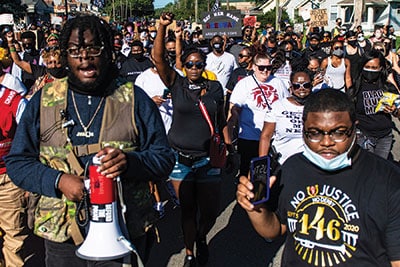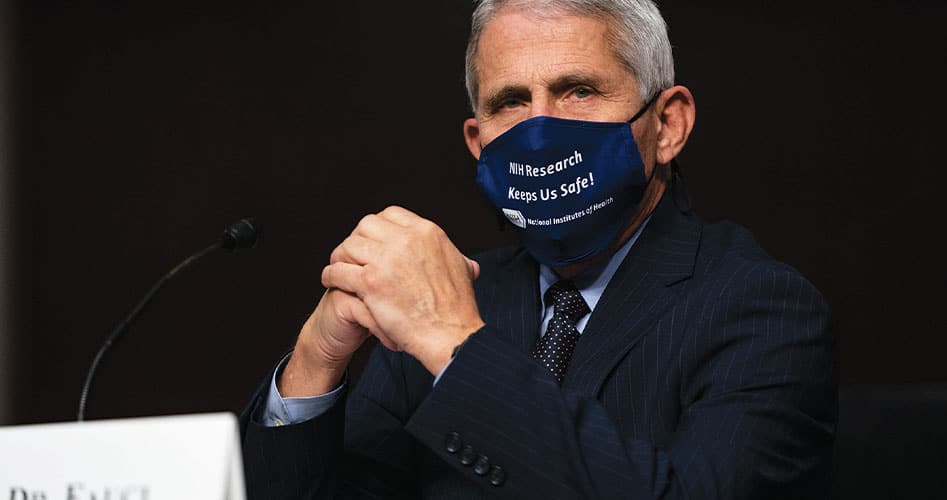The Many Masks of Anthony Fauci
Anthony Fauci contradicts himself so often that we literally can’t believe anything he says.
Selwyn Duke
America’s COVID-19 guru Anthony Fauci contradicts himself so often that we literally can’t believe anything he says.
That “Fauci” in Italian means “jaws” or “mouth” certainly lends itself to some humor. First, there’s how our Dr. Anthony Fauci just loves talking to the media, attracted to cameras like a moth to flame. Then there’s how Lockdown Tony had helped position us in the gaping maw of economic death. There’s also, however, how heeding his counsel has placed us in the jaws of confusion — within which he, apparently, has been ensnared for decades.
Unbeknownst to most, the 79-year-old Fauci could be our country’s longest-serving bureaucrat, having been with the National Institute of Allergy and Infectious Diseases (NIAID) since 1968 and acting as its director since 1984. He’s not actually an immunologist (or an epidemiologist or virologist. Get the gist?), however, though he’s often thus billed. His bio lists only a medical degree in internal medicine as relevant credentials, yet the Sun Sentinel, for example, called Fauci “the nation’s leading expert on infectious diseases.” Where he’s leading, though, is the question.
While the current Wuhan virus pandemic has raised that question in the minds of many, the doctor’s expertise was put to the test at least as far back as AIDS’ emergence in the 1980s. It was then that “Fauci claimed that AIDS might be transmissible by ‘routine close contact.’ (May 5, 1983, issue of the Journal of the American Medical Association),” wrote the Gateway Pundit’s Jim Hoft April 5. “Fauci claimed that ten percent of the HIV/AIDS infected would be heterosexual — more than two and half times the rate — four percent — it actually was,” Hoft continued.
Apropos to this, it was common knowledge in the ’80s that AIDS affected mainly the “three H’s”: heroin users (sharing dirty needles), hemophiliacs (contaminated blood received via transfusions), and homosexuals (high-risk sexual practices). But not according to Fauci, Hoft relates. When columnist George Will told the doctor on February 15, 1987 that HIV/AIDS mainly plagued homosexuals and that it was not exploding into mainstream America, Fauci shot back, “That’s not correct…. It is projected that that [heterosexual] number will be up in 1991 to about 10 percent.”
Now, there’s a parallel here involving our time. That is to say, insisting that everyone was gravely imperiled by the Wuhan virus no doubt contributed to not focusing resources and attention where they would do the most good — for instance, on nursing homes, in which 40 to 50 percent of our virus deaths have occurred. Likewise, Fauci’s ’80s counsel might have prevented us from directing attention during the AIDS situation where it belonged: on the homosexual population. Note here that the 10-percent heterosexual infection rate “claim was a standard talking point of his,” as Hoft puts it.
But Fauci doesn’t seem to have many standard talking points with the Wuhan virus today, as he has regularly contradicted himself in significant ways. As Hoft reported April 13, “Dr. Fauci says he warned Trump in January that the US was in real trouble but that is not what he said publicly.” Rather, on January 21, “Dr. Anthony Fauci told Newsmax TV that the United States ‘did not have to worry’ about the coronavirus and that it was ‘not a major threat,’” Hoft relates.
Fauci then repeated this pattern. In an Easter Sunday interview with CNN’s Jake Tapper, Fauci claimed “that the government had been advised to begin social distancing measures in February,” the U.K. Sun informed. “We look at it from a pure health standpoint,” Fauci said. “We make a recommendation, often the recommendation is taken, sometimes it’s not.” The doctor echoed this later that day on MSNBC, telling host Al Sharpton that he warned the administration in mid- to late January that “we were in real trouble” because of COVID-19.
Yet when he himself was asked on the February 29 edition of the Today Show if Americans should change their habits, Fauci answered, “No, right now, at this moment, there is no need to change anything that you’re doing on a day-by-day basis.” The doctor has never explained these contradictions.
As Hoft also reported April 13:
Dr. Fauci warned of an apocalyptic coronavirus pandemic — then just weeks later he … compared the coronavirus to a bad flu.
Dr. Fauci based all of his predictions on … IHME [Institute for Health Metrics and Evaluation] models that were OFF BY MILLIONS and then told reporters this past week, “You can’t really rely on models.”
Dr. Fauci pushed these … models every step of the way.
Three weeks ago Dr. Fauci claimed 1 million to 2 million Americans would die from coronavirus. Then he said 100,000 to 200,000 Americans will die from the virus. Then last week he agreed 81,766 Americans would die from the coronavirus. Then by Wednesday the experts cut the number of deaths to 60,415 projected deaths.
Of course, one of the doctor’s guesses could be correct, but to know which one we’d have to ascertain how many Americans have actually died of COVID-19. That number is officially about 206,000, yet according to the CDC’s own statistics only about six percent of those who died with COVID-19 died because of COVID-19 alone.
What’s the Travel Ban Plan?
Next there are Fauci’s migrating positions on travel restrictions. On February 26, he was asked by CNBC host Sara Eisen, “Is there any talk of closing flights from Europe or flights from Asia, outside of China?”
“No, I don’t think at all that that will happen,” the bureaucrat answered. “When you have a pandemic that involves multiple countries, travel restrictions become almost irrelevant because you can’t keep out the entire world.” Doubling down, Fauci later reiterated that “when you have multiple countries involved it’s very difficult to do that. In fact, it’s impossible.”
Just a bit more than two weeks later, however, Fauci believed in the impossible. While addressing the recently instituted travel restrictions involving China and Europe, he told reporters on the White House lawn March 12 that they were a “prudent choice” because a majority of the United States’ new cases “are from Europe.” “We spent a lot of time thinking about it, discussing it, about whether we should do it,” he explained — “and it was the right public health call.”
Back to School?
Then there was Fauci’s answer when Senator Rand Paul (R-Ky.) suggested, during May 12 Senate testimony, that schools should reopen come fall. Paul, a physician himself, pointed out that New York data showed that the Wuhan virus mortality rate for individuals aged 0 to 18 “approaches zero.” Unmoved, Fauci replied, “We really better be very careful, particularly when it comes to children, because the more and more we learn, we’re seeing things the virus can do.” Yet in a CNN phone interview just three weeks later (June 3), Fauci said that “to make an extrapolation that you shouldn’t open schools [in the fall], I think is a bit of a reach.”

Kid you not: The flu is more dangerous to children than is COVID-19, which poses almost no threat to them at all. Yet authorities maintain the illusion — once enabled by Fauci — that opening schools is a danger to the young. (Photo: AP Images)
In fairness, at least this is an area where Fauci hasn’t made definitive pronouncements — the problem is that it’s an area where he should have. As the Washington Post reported September 12, German schools had seen no coronavirus outbreaks since reopening a month before. This just reflects earlier data showing that, as the Telegraph told us May 18, no virus spikes were “found after re-opening schools in 22 EU countries.” Note, too, that a study out of Britain’s Newcastle University found that children under 10 are twice as likely to die of the flu as of the Wuhan virus; moreover, other research indicates that kids don’t readily spread the latter to others.
Where Fauci has been more definitive (at least provisionally) is in his predictions regarding autumn in general. He told MSNBC in April, “It’s inevitable that the coronavirus will return next season.” Yet a month later Fauci sang a different tune: “We often talk about the possibility of a second wave, or of an outbreak when you’re reopening,” he told CNN in a May 27 interview. “We don’t have to accept that as an inevitability.”
Now Fauci takes a somewhat different position altogether, saying that there won’t be a second wave because we never emerged from the first one. As he warned a Harvard Medical School Grand Rounds session in September, reported Newsweek on 9/11, “I just think we need to hunker down and get through this fall and winter because it’s not going to be easy.”
Is Donning a Mask a Holy Task?
Regarding face masks, which increasingly appear to be our current collective version of Linus’ security blanket, Fauci’s stance has also varied depending, well, on what mask he was wearing at the time. “No, right now, people should not be wearing — there’s no reason to be walking around with a mask,” the physician told CBS’ 60 Minutes on March 8. “When you’re in the middle of an outbreak, wearing a mask might make people feel a little bit better, and it might even block a droplet. But it’s not providing the perfect protection that people think that it is,” he elaborated. “And often there are unintended consequences; people keep fiddling with the mask, and they keep touching their face.”
A couple of months later in early May, however, Fauci recommended during Senate testimony that people wear masks whenever they can’t socially distance. You should get “some sort of a covering,” said he, citing a CDC recommendation. But here’s the kicker: Explaining his reversal, Fauci said, “Back then we were concerned we would be taking masks away from the healthcare providers.”

The incredible shrinking social distance: Fauci gave new meaning to “game of inches” when he was caught at a July baseball game up close and personal and unmasked. PR-wise, it wasn’t exactly a home run. (Photo: AP Images)
This apparent deception raises a question: If Fauci was lying then, how can we be sure he isn’t lying now? Whatever the case, by late May Fauci had done a complete 180 and said that everybody should wear a mask in public, that he wears one as a “symbol” of right action, and that it shows “respect for another person.”
Note that the doctor would later be caught on video July 23 at Nationals Park stadium in Washington, D.C., neither social distancing nor wearing a mask.
A Shot in the Dark?
Injecting more confusion, Fauci has also changed his tune on vaccines. After Health and Human Services Secretary Alex Azar made a fear-assuaging statement on March 3 to the effect that rapid progress was being made on developing a vaccine, Fauci chimed in to “‘caution everybody’ that what Azar described is only the first phase of the development of the vaccine,” reported Business Insider at the time. “The whole process is going to take a year, a year and a half, at least,” Fauci said, definitively, while standing a few feet from President Trump (unmasked!).
Yet addressing a question about biotech company Moderna’s developments while speaking to NPR May 22, Fauci said, “I think it is conceivable … that we could have a vaccine that we could be beginning to deploy at the end of this calendar year — December 2020 or into January 2021.”
Of course, it’s understandable that such projections could change. But as ancient Chinese sage Confucius wrote, “Wisdom is, when you know something, knowing that you know it; and when you do not know something, knowing that you do not know it.” Fauci will turn 80 this December, and he has been with the NIAID for 52 years. He should know that medical advances are complicated, hard-to-predict matters. He should also know that there’s nothing wrong with uttering certain three words: “I don’t know.”
Consider also what I omitted with an ellipsis from Fauci’s May 22 statement. To wit: We can have a vaccine by year’s end “if we don’t run into things that are, as they say, unanticipated setbacks.” It’s notable that the doctor included a qualifier with his good news (as he should), but was definitive when delivering fear-inducing bad news.
As an aside, completely unacknowledged by Fauci is that the vaccine search may be a fool’s errand, anyway. As the Atlantic’s James Hamblin related in February, “‘If we’re putting all our hopes in a vaccine as being the answer, we’re in trouble,’ Jason Schwartz, an assistant professor at Yale School of Public Health who studies vaccine policy, told me. The best-case scenario, as Schwartz sees it, is the one in which this vaccine development happens far too late to make a difference for the current outbreak.”
Protest Over Prayer?
“I feel like we are living in a George Orwell novel.” So said an Internet commenter in June, in reference to the politicians who encouraged Black Lives Matter protesters/rioters to hit the streets, but placed COVID-19 restrictions on everyone else. Grilled about such contradictions July 31 while testifying before the House of Representatives, Fauci was asked by Congressman Jim Jordan (R-Ohio) “if he thought the government should crack down on [BLM] protests similar to how the government has banned churches from congregating or businesses from operating,” reported Daily Wire at the time. “After admitting that crowds of people increase the chance of spreading the disease, Fauci demurred on whether the government should ban protests.”

A “woke” virus: Politicians’ schizoid restrictions make sense if you believe SARS-CoV-2 will infect churchgoers, small business owners, college students, and gym attendees but not throngs of left-wing activists. Perhaps the virus was seen under a microscope wielding a BLM sign. (Photo: AP Images)
For example, Jordan pressed Fauci and said, “Well, you make all kinds of recommendations. You make comments on dating, on baseball, on everything you can imagine. I’m just asking, you just said protests increase the spread. I’m just asking, should we try to limit the protest?” (In fact, the doctor didn’t shrink from providing specificity in mid-July, when he recommended closing bars.)
“I think I would leave that to people who have more of a position to do that,” was Fauci’s evasive response.
Yet Fauci’s perhaps most striking moment was when Jordan asked, pressing the bureaucrat, “So you’re allowed to protest millions of people on one day in crowds yelling, screaming, but you try to run your business you get arrested? And if you stood right outside that same business and protested you wouldn’t get arrested? You don’t see an inconsistency there?” Fauci refused to acknowledge the obvious contradiction and instead stated, “I don’t understand what you are asking me as a public health official to opine on who should get arrested or not. That’s not my position. You can ask as much as you want and I’m not going to answer it.”
Don’t Shake Hands!
Then there are the Fauci contradictions that truly raised eyebrows. On a Wall Street Journal podcast April 7, the man who once said Americans needn’t change their behavior stated that he didn’t think they “should ever shake hands ever again.” But then a week later, April 14, he said in a Snapchat Good Luck America interview that it was okay to have sex with a stranger you meet via a dating app if “you’re willing to take a risk — and you know, everybody has their own tolerance for risks.”
Yet this raises a question: Why the lockdowns then? Isn’t everything — from visiting hair salons and gyms and restaurants and parks to shaking hands — a matter of “if you’re willing to take a risk”?
Gods of the Moving Goalposts
Even more striking, perhaps, is how the criteria for returning to post-pandemic normalcy have consistently changed as soon as they were met. First we were told that we needed to stay “locked down” for two weeks, or perhaps somewhat longer, to “flatten the curve” and ensure the healthcare system wasn’t overloaded. “In many respects, it’s not whether the situation is going to get worse but how quickly,” wrote USA Today March 11, pointing out that the total number of people infected may end up being the same. “In flattening the curve, the goal is not so much to reduce the total number of people getting sick but to slow the rate at which they do,” the paper later emphasized. USA Today also quoted Emily Gurley, an associate scientist in the Department of Epidemiology at the Johns Hopkins Bloomberg School of Public Health, as saying, “Our best guess is that most people are going to get this virus at some point.”
The healthcare system was never overwhelmed, however, and the models showing it could be — even those factoring in mitigation efforts — were revealed as gravely flawed. This was when lockdown justification B was put forth as if A had never existed. To wit: We were told that a state should experience a “decline in cases over a 14-day period” before reopening, as NBC News related it April 28.
Next we moved on to Justification C, which was that “we will be facing rolling waves of restrictions and shutdowns until we have a vaccine,” as Scientific American put it July 18. Now we have Justification D, the Mother of All Justifications: We can never return to normalcy.
As World Health Organization Director-General Tedros Adhanom Ghebreyesus proclaimed during a news conference from the agency’s Geneva headquarters, “We will not, we cannot go back to the way things were,” CNBC reported August 21. “Throughout history, outbreaks and pandemics have changed economies and societies,” the outlet writes, summarizing his message.
“‘In particular, the Covid-19 pandemic has given new impetus to the need to accelerate efforts to respond to climate change,’ Ghebreyesus said,” CNBC continued. “The Covid-19 pandemic has given us a glimpse of our world as it could be: cleaner skies and rivers.” How this will stop China from releasing deadly viruses from its labs was not explained.
As for Fauci, being our federal point man on the pandemic and its management’s face, it would’ve helped if he’d provided a steady hand and message to help negotiate this orchestrated confusion.
So what drives Fauci? For one thing, he’s a career bureaucrat showing no signs of wanting to retire, and, hey, you don’t get to work in government under nine presidents without “playing the game” — and the game isn’t science. Just consider how Fauci ingratiates himself to the powerful, having once concluded an adoring 2012 e-mail sent to Hillary Clinton by way of her aide/lawyer Cheryl Mills with, “Please tell the Secretary that I love her more than ever[,] you guys too, of course. Best regards, Tony.” (The next Clinton “love letter” was signed “Warm regards.”) But that the doctor loves the camera even more and apparently craves attention are also troubling. I believe Fauci may be a narcissist, a man who craves the feeling of being listened to and considered intellectual; he may revel in sounding authoritative and in command and be willing to say anything to effect that image at the moment. In fact, one could get the feeling that, deep down, he has an emotional vested interest in perpetuating the pandemic and, with it, his 15 minutes of fame.
Making it permanent may not be hard, either. Not only did Fauci co-author an August 15 report stating that the China virus “should force us to begin to think in earnest and collectively about living in more thoughtful and creative harmony with nature” — but he also said in July that he didn’t think the coronavirus would ever be eradicated.
Perhaps the simplest analysis of Fauci, however, was provided by Dr. Knut Wittkowski, former longtime head of the Department of Biostatistics, Epidemiology, and Research Design at the Rockefeller University in New York City. Wittkow-ski warned early on that lockdowns were misguided, saying that herd immunity and the virus’ eradication could be achieved in weeks with the right policy. When asked to explain why Fauci would nonetheless prescribe lockdowns and warn of life disruptions lasting years, Wittkowski replied, “Well, I’m not paid by the government, so I’m entitled to actually do science.”

